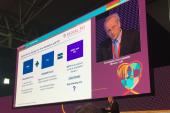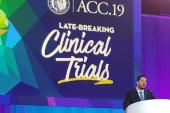Dual Bests Triple Therapy in Nonvalvular AF Patients in RE-DUAL PCI
A landmark analysis supports dropping aspirin by 7 days in most patients, and by 30 days in all, to avoid bleeding.

Dropping aspirin soon after PCI seems to be the best strategy for preventing bleeding in high-risk patients with nonvalvular atrial fibrillation (AF), according to a landmark analysis of the RE-DUAL PCI trial.
As reported by TCTMD, RE-DUAL PCI supported moving away from a triple-therapy strategy—P2Y12 inhibitor, warfarin, and aspirin—in these patients in order to lessen bleeding without increasing the risk of thrombotic events.
The new data in conjunction with the rest of the available evidence, including those from AUGUSTUS, “are pretty clear that that strategy of prolonged triple therapy almost should never be used,” study co-author Deepak L. Bhatt, MD, MPH (Brigham and Women’s Hospital, Boston, MA), told TCTMD. “Our article sort of helps bring some granularity to the sort of minimum duration of aspirin that's probably needed.”
Specifically, the researchers, led by Benjamin E. Peterson, MD, MPH (Brigham and Women’s Hospital), write that because the average time from PCI to randomization in this study was only 1.6 days, “the effects of a dual-therapy approach, without increased risk for thrombotic events, can apply even with just 1 or 2 days of aspirin post-PCI.”
Commenting on the study for TCTMD, Roxana Mehran, MD (Icahn School of Medicine at Mount Sinai, New York, NY), said that most of these patients do not need to stay on aspirin past 7 days. “In certain cases where you're worried, you can go up to 30 days, but beyond that, you really should be thinking about avoiding bleeding,” she said.
Landmark Analyses
For the study, published in the April 12, 2021, issue of JACC: Cardiovascular Interventions, Peterson and colleagues conducted landmark analyses at 30 and 90 days of the 2,725 patients from RE-DUAL PCI who were randomized to receive dual therapy—the non-vitamin K antagonist oral anticoagulant (NOAC) dabigatran at a dose of 110 mg or 150 mg plus a P2Y12 inhibitor (and no aspirin)—or triple therapy—warfarin plus a P2Y12 inhibitor plus aspirin.
Those receiving dual therapy saw a 55% reduction in major or clinically relevant nonmajor bleeding at 30 days compared with the triple therapy group (HR 0.45; 95% CI 0.31-0.66). There was also early net clinical benefit (a composite of major bleeding or clinically relevant nonmajor bleeding, death or thromboembolic event, and unplanned revascularization) observed for both dabigatran doses compared with warfarin that was driven by less bleeding (110-mg dose HR 0.65; 95% CI 0.47-0.88; 150-mg dose HR 0.54; 95% CI 0.37-0.79).
When patients assigned to triple therapy dropped aspirin, 30-day bleeding rates dropped to similar levels of those receiving dabigatran 150 mg but were still 31% higher than those seen with dabigatran 110 mg.
“The point here is you do want to make sure the patient gets aspirin, but that aspirin in the hospitalized phase of care for that 1-2 days is probably sufficient,” Bhatt said. “Discharging the patient on an appropriate dose of full anticoagulation, so a NOAC as per the label is appropriate for that patient's age or renal function or whatever, plus a P2Y12 inhibitor, most often clopidogrel, does seem to be the way to go. . . . Going beyond a month is almost never warranted in these types of patients.”
The modest subgroup of patients from RE-DUAL PCI who received ticagrelor instead of clopidogrel “seemed to do fine as well but I certainly would never combine ticagrelor or prasugrel with triple therapy,” he added. “That is asking for bleeding complications.”
Breaking Down the Data
In an editorial accompanying the study, Davide Capodanno, MD, PhD (University of Catania, Italy), writes that “insightful new lessons” can be drawn from the new data. “First, during the initial 30 days, dabigatran 150 mg dual antithrombotic therapy was associated with the lowest crude rate of ischemic or thrombotic events, which is notable because the time of periprocedural triple antithrombotic therapy was short (eg, mean time to randomization was 1.6 days in REDUAL PCI vs 6.6 days in AUGUSTUS). This effect was not observed with dabigatran 110 mg [dual therapy], underscoring the superior thrombotic protection of the higher dabigatran dose.”
Also, Capodanno says, over the long-term, the lower dabigatran dose emerged as the safest, “but the low rate of thrombotic or ischemic events precludes further considerations on efficacy. It is reassuring to note, however, that the rate of thrombotic or ischemic events after the early period is relatively low with current-generation DES.”
“Overall, these results suggest that [direct oral anticoagulant (DOAC)] doses matter, and modulation of anticoagulation intensity deserves more consideration as a way to personalize antithrombotic treatment over the course of time according to individual thrombotic and bleeding risk profiles,” Capodanno continues. For example, it could be worthwhile to start a patient on the higher dose in the hospital but then drop aspirin and eventually use the lower-dose DOAC through 1 year.
Even with all the available data, clinical practice is still “a bit misaligned,” according to Bhatt. “I see this happening a lot where patients are treated with full-dose triple antithrombotic therapy for prolonged periods of time well beyond a month,” he said, citing a recent case where a younger woman had been on triple therapy for an extended period because her bleeding risk was presumed to be low due to her age. “The problem is that that might be true in an individual practitioner's experience, but the studies are pretty clear that when you put patients on full-dose triple therapy, even ones that are relatively young, bad bleeding can occur,” stressed Bhatt.
Mehran agreed that clinician behavior has not fully adapted to the new consensus. “The issue is that doctors will see a patient who's been on 30 days of triple therapy and they're doing well, and you put in a bunch of stents and they're like, ‘OK, keep going. You haven't bled,’” she said. “Well, when you wait until the first bleeding episode, then you didn't prevent that bleed.”
Ongoing studies like MASTER DAPT may give further insight into refining optimal drug combinations and durations. “No matter what all these trials might show, I think ultimately it's going to be up to the treating physician to decide for that individual patient just how high are the ischemic risk, the bleeding risk, and the periprocedural risk from the stenting procedure if one were done in this context and to try to weigh all those factors,” Bhatt said. “But at least for the average patient, hopefully this analysis provides further reassurance that abbreviating the duration of aspirin is the right thing to do.”
Yael L. Maxwell is Senior Medical Journalist for TCTMD and Section Editor of TCTMD's Fellows Forum. She served as the inaugural…
Read Full BioSources
Peterson BE, Bhatt DL, Steg PG, et al. Evaluation of dual versus triple therapy by landmark analysis in the RE-DUAL PCI trial. J Am Coll Cardiol Intv. 2021;14:768-780.
Capodanno D. Triple therapy, dual therapy, and modulation of anticoagulation intensity. J Am Coll Cardiol Intv. 2021;14:781-784.
Disclosures
- This work was funded by Boehringer Ingelheim.
- Peterson reports no relevant conflicts of interest.
- Bhatt reports receiving research funding or unfunded research support from Abbott, Amarin, Amgen, AstraZeneca, Bayer, Boehringer Ingelheim, Bristol-Myers Squibb, Chiesi, Eisai, Ethicon, Forest Laboratories, Idorsia, Ironwood, Ischemix, Lilly, Medtronic, PhaseBio, Pfizer, Regeneron, Roche, Sanofi, Synaptic, The Medicines Company, FlowCo, Merck, Novo Nordisk, PLx Pharma, and Takeda; being a site co-investigator for Biotronik, Boston Scientific, St. Jude Medical, and Svelte; being a trustee for ACC; serving as an advisory board member, director, or chair for Cardax, Elsevier Practice Update Cardiology, Medscape Cardiology, Regado Biosciences; the Boston VA Research Institute, the Society of Cardiovascular Patient Care, TobeSoft; the American Heart Association Quality Oversight Committee; serving on a range of data safety monitoring committees; receiving honoraria for editorial or committee activities for a range of publications and organizations; and receiving royalties from Elsevier.
- Capodanno reports receiving speaker and consulting honoraria from AstraZeneca, Bayer, Boehringer Ingelheim, Daiichi-Sankyo, and Sanofi.
- Mehran reports institutional grants from Abbott Laboratories, Abiomed, Applied Therapeutic, AstraZeneca, Bayer, Beth Israel Deaconess, Chiesi, Concept Medical, CSL Behring, DSI, Medtronic, Novartis Pharmaceuticals, OrbusNeich; personal fees from Abbott, Boston Scientific, Cine-Med Research Institute, Janssen Scientific Affairs, Medscape/WebMD, Sanofi, Siemens Medical Solutions; and consultant fees for Regeneron Pharmaceuticals.





Comments